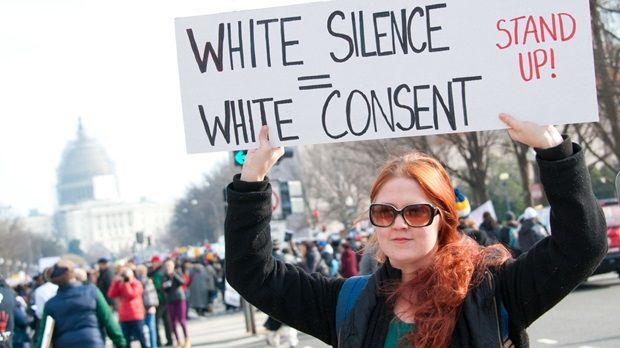
The week after the violence in Charlottesville, I spoke with my father about the neo-Nazis and how emboldened they are right now. He said that he was proud to have a daughter who was standing up to racism. Not more than a few sentences later, however, he advised that I stay away from any demonstrations of white supremacists and leave them for the police to handle. He wasn’t alone in his opinion. Just hours earlier I’d spoken with a friend in Boston who was torn because of a statement issued by the Southern Poverty Law Center advising groups to create their own protests on different days instead of risking violent conflicts via counter-protesting.
I felt conflicted. Already on my calendar was a plan for the following week to attend a rally in Southern California as a counter-protestor. I shifted the frame slightly by saying, “Dad, “I can’t stay away. They’re coming to me.” I then proceeded to tell him about the July and August meetings of a local multi-racial committee that works on issues of racial justice. It’s not a meeting I attend regularly, but I’ve been a few times before and I have known a few of the organizers for years. I wasn’t at their meeting in July when a handful of white supremacists arrived and vocally disrupted the meeting with anti-Semitic and racialized hate speech. I heard about it though, and I was there in August when over 30 of them showed up.
What I’d like to share are four lessons I’ve learned through my experiences in the past couple of months about white supremacists and responses to their actions.
- The police may not provide the support white people tend to expect. I’m sure police policies and procedures vary. So I have no idea if what I’m going to say translates to other locales. But, I was surprised by the inaction of the police during the August meeting. The organizers had attended a planning meeting with city and police officials, warning them of what they knew about the white supremacist folks recruiting to disrupt the August gathering. Because of this, there were at least 10 or more uniformed police in a solid row standing in front of the venue when I arrived. There were also about 20 disrupters, many of whom were dressed in black and wearing masks, harassing meeting attendees, capturing video of those who were provoked into answering back. The police did nothing to interrupt this. Apparently, keeping the meeting attendees from being harassed would have trampled on the disruptors’ freedom of speech.
The white supremacists had been successfully kept out of the room that August evening, the room being full to capacity, and so doors were closed and locked at various points. However, a group of them stationed themselves outside at either door so that when a member of our group needed to enter or leave, the disrupters would grab the doors and attempt to swing them wide open in order to gain access. Again, the police did nothing to stop this. Within the room, many participants (including myself) felt intimidated. What is perhaps unsurprising, but horrifying, was that the larger and more muscular of us in the room were black men, willing to step up and pull those doors shut. I was grateful for their presence and willingness to step in. And yet many of us were aware that if a scuffle actually broke out, it would be unlikely that these black men would be considered victims in the situation. As a white person in the room, I considered taking a place at the door. As a woman, I felt cautious (scared, really). And, as a visitor to someone else’s space, I wasn’t sure what the organizing committee had planned, and I didn’t want to rush in as though I knew what was best. I didn’t.
A bit later, after the organizers complained to the police about our need for assistance, seven officers stationed themselves inside the doors. This reduced the efforts of the disruptors, although they continued to pull on the doors occasionally. Some of them then began walking around the building, knocking loudly on the windows. The police did nothing to stop this disruptive behavior.
A couple of weeks later, I attended a collaborative share out meeting where several groups came together to tell their stories of how right-wing and/or white supremacist groups had been disrupting and harassing people at their meetings. I learned that each of these committee groups had consulted with the police prior to the meetings where disruptions occurred. Each of them had been given precise instructions on what to do to comply with the law (as these are public meetings) and allow police to do their job effectively. In the two primary cases I heard, both sets of organizers lamented that even after following the police chief’s instructions, officers did not intervene to help de-escalate the situations. They didn’t even take the action they said they would be able to take if the instructions were followed. There was a disconnect between what the police chief said would happen, and what the officers were willing to do.
- Radical groups on the left exist for a reason. After the disruption that occurred at the August meeting, a mobilization effort resulted in over 300 anti-racist white people showing up to support the September meeting. De-escalation and safety teams were formed and trained. Volunteers followed the organizers’ plans, and thankfully, only a handful of white nationalists showed up. The influx of anti-racist white folks attending the meeting presented an interesting learning opportunity, however. As I stood in line waiting to be let into the meeting room, I watched as about a dozen black-clad individuals wearing masks and boots lined up facing those of us waiting to enter the meeting. Admittedly, I nervously scanned their attire to find some hint of their affiliation. One hat had a swastika symbol with a red circle around it and a line through it. Another’s hat had a patch on it with a gun and the words, Redneck Revolt. I had read an article a few months back about Redneck Revolt, and had been joyful about their existence. These folks were on our side. They had come to offer protection. I relaxed.
I then watched as a number of others, one by one, approached to ask who they were and why they were there. A woman behind me began to lament their presence, calling it antagonistic. Another woman standing directly behind me responded that they made her feel safer. The three of us then spent time in a discussion about safety, protection, intent, and the value of radical organizations. I recalled reading that several clergy wrote about how some antifa (anti-fascist) folks in Charlottesville had protected them during the melee. The clergy were vocal about feeling that they would have been in serious trouble without the help of antifa. A few minutes later, I saw someone holding a quarter sheet leaflet that explained the Redneck Revolt’s purpose. It was clear and helpful for those who hadn’t heard of them before.
For me, this experience highlighted the difference between having a theoretical analysis of an issue and the real, visceral emotion it arouses. I left that experience clearer about my need to articulate the value of radical, leftist organizations that seek to protect the peaceful. Yes, I felt nervous and intimidated at first. Yes, I would prefer that they not be needed. And yet, after seeing how the police allow intimidation to take place (staying neutral until a threat of violence actually occurs), I felt safer with the Redneck Revolt standing by, ready to take action if needed.
- The Alt-right is successfully recruiting people through slick propaganda as well as misinformation. The organizers putting on these meetings were forced to do some serious homework and research on these white nationalists, and this was on display at the sharing out meeting I attended. Through social media, the primary organizer of the white nationalist folks and their various other linked groups were identified. The propaganda flyer the white nationalists fabricated to recruit people to our event was full of racist imagery and inflammatory language about it being an anti-white group. No wonder their recruitment was so successful! We also learned that part of their primary interest in showing up to these meetings was not really about shutting us down. It was about provoking people of color to react so that they could get angry folks on video and then to use those videos for recruitment and fund-raising.
Just this week, I read a post by Abe Lateiner called, Learning to Speak Alt-Right, who makes this point very clearly. In fact, his post goes farther than what I experienced. These alt-right folks are also recruiting using seemingly-innocuous language that speaks to many mainstream white people who feel conflicted about the changing nature of our society and how identity plays a role. And, once they get someone inflamed and upset, they add a racist rationale that furthers the recruitment. Those of us who are invested in anti-racism need to pay close attention to this and develop and promote strategies to counteract this trend.
- Conceding the streets to neo-Nazis cannot happen. At the September meeting, there were twelve local clergy, two city councilmen, and the mayor. All had been lobbied to support the racial justice committee. It felt good in the room that night. The fact that this group was unwilling to concede to the disrupters, refused to end the August meeting early, and refused to cancel the September meeting is essential. The fight it took to get the city council representatives in the room was worth it too. It felt important that they made a stand to say that hate would not be welcome in the city. True, the organizers put in many hours strategizing and coordinating to ensure the meeting could take place successfully, and hopefully this level of planning will not need to continue month after month. It makes the point, however.
Neo-Nazis cannot be allowed to take over a street and have citizens who care about equity and justice feel that they cannot be present. It empowers them, invites them to take further action, and leaves their message hanging too long in the air for others to grab hold of. I am certain that if equity-minded people stay out of the streets to let white supremacists have that ground to themselves it allows all those being targeted by their hate speech to feel violated, intimidated, unprotected, and undefended. And, it means those of us who care are acting out of fear instead of principle. I won’t live like that. History is clear that a visible response is needed. A week after my call with my dad, where he told me to stay away from counter-protesting, he and I spoke again. This time, he said, “You know, I was thinking about it, and you were right. It’s essential that people stand up.” And I can say to him that I’m proud to have a dad who, as a former police officer who is likely concerned for his daughter’s safety, keeps an open mind and learns along with his daughter.
